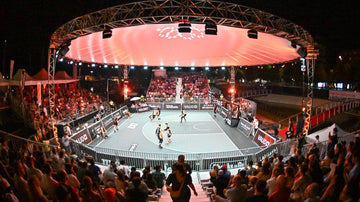The fast break and transition offense occurs when you gain possession of the basketball and push the ball as quickly as possible up the floor via the dribble or the pass. You can gain possession of the ball by a turnover, rebound, blocked shot, or an attempted shot.
You always want the fast break to be your first offensive option.
Why should you fast break?
- To get easy scoring opportunities- Many teams have great half-court defenses when they are set. Whether it's an advantage fast break 2v1, 3v2, etc or 5v5 transition offense situation, the fast break allows you to attack the defense before it can get set which can lead to many easy baskets for your team. If an easy basket does not present itself, they transition directly into your offense to keep the defense on their heels.
- Control tempo & force bad decisions for your opposition- Some teams are not used to playing a fast tempo. Due to your opponents' lack of repetitions running the fast break, this can lead to more bad decisions for your opposition which would be advantageous for you.
- Wear teams down- If you practice the fast break every day during practice, chances are that your players will be in pretty good condition. Your opponents may not spend as much time running the break, so when you pick up the temp, this will wear on your opponents. It may not happen right away, it may not happen until the last 4 minutes of the game. Paul Westhead's teams were known for wearing teams down, then going on enormous runs in the second half.
If you have 9 or 10 players, this can also be a great way to wear the teams down. It is also a great way to develop your underclassmen.
- Beating zones and pressure- Many coaches will say that your best offense against a good zone or defensive pressure is your fast break and transition offense. As mentioned before, you want to get the ball up the court for easy scoring opportunities before the defense can get set.
- Aggressive mentality- When taught properly, the fast break can lead to an aggressive offensive mentality. If you watch the best players in the world, they usually have that "attack" mindset. Quite often, the difference between average players and good players is their mindset. If you can get all of your players with the same mindset, it could lead to a much better team. This doesn't mean that everybody on your team is jacking up 3's or the first open jump shot, your players should just do what they do well with assertiveness.
- Offensive rebounds- Many rebounders are not good at running the floor. When you big man is conditioned, it will lead to many more opportunities. Danny Miles will sub his post players more frequently than his post players because post players have to cover more ground on each possession. This helps keep his post players fresh. Danny typically subs his post players every 4 minutes.
- Players enjoy it- Players are more likely to buy in and want to participate if you provide a style of play that is enjoyable to play.

Are there situations where you should not run the fast break?
Against talented, athletic teams, you may choose to slow down your offense, but I don't believe that you want to completely dismiss fast breaks because they could lead to some very easy baskets. In this situation, you may enforce a "lay up" only rule. If you get an advantage, take a lay up.
If no advantages are presented out of the fast break, you could set a rule that you only take lay ups until a specified time or number of passes. Some examples are:
- No jump shots until 30 seconds have passed.
- No jump shots until 10 passes have been made.
- No jump shots until the ball has been reversed 5 times.
- No jump shots until the ball has touched the post twice.

Running Your Transition Offense
Running a transition offense, at least a good one, is a lot more than just running up and down the floor as fast as you can. For a break to be truly effective in a transition system, the break must fit seamlessly with which ever half court offense you have chosen to run.
The purpose for a transition system is to take advantage of your opponent's break downs while they are changing from offense to defense or from defense to offense. It is designed to take control of and lengthen the transition period. Openings will exist as your opponent is making the transition giving your team a great opportunity to take advantage of openings. It would be counter productive to your goals and objectives if you had to hold the ball out to reset your offense and give the defense a chance to organize and defend.
Types of Fast Breaks
The Numbered Break - In a numbered break you assign numbers to each player.
1 is the point guard and can bring the ball up the left side of the floor or the right side (not the middle, we want the point picking a side). You can allow the point guard to choose a side or if you prefer, you can specify that point always goes up a certain side (ex: right side).
2 sprints to the spot in the right corner.
3 sprints to the spot in the left corner.
4 inbounds the ball and trails filling the wing opposite the ball (in this example it's the left wing).
5 sprints to the strong side block.
The numbered break is easy to teach because players always go to the same spot.
Motion or Free-Flow Break
The best and the simplest break I have ever experienced did not have multiple cuts or transition options. I have learned that it gets you up the court quickly and fits with any transition offense. It is simple and you can teach it in a minute. I recommend that everyone try it, at least for a little while.
The break is simple: If you are ahead of the ball, run wide; if you are behind the ball, run down the middle. Everything else pretty much takes care of itself.
You can figure out the trailers, you can figure out where the wings go. You can even have players run in the same lane. As long as they finish in spots where your offense can continue, there is no harm. In fact, if you have 2 players run in the same lane, as long as they are properly spaced, the first cutter will strip the defense for the second cutter and you might find opportunities where none were present before.





